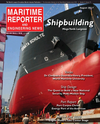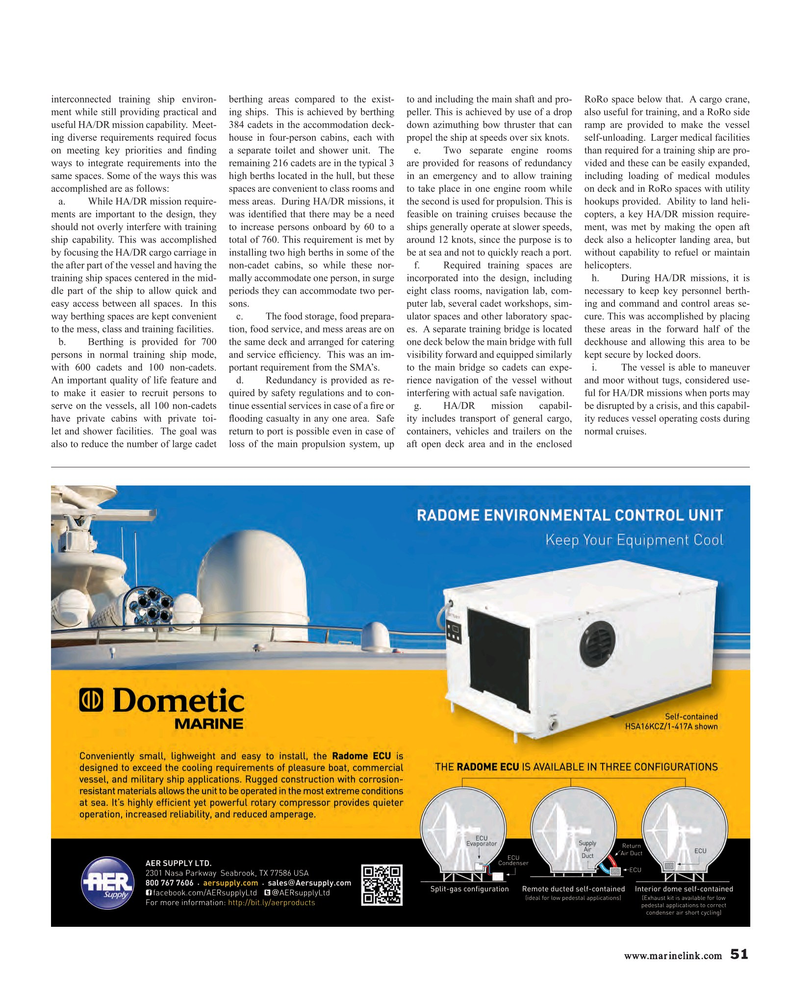
Page 51: of Maritime Reporter Magazine (August 2017)
The Shipyard Edition
Read this page in Pdf, Flash or Html5 edition of August 2017 Maritime Reporter Magazine
interconnected training ship environ- berthing areas compared to the exist- to and including the main shaft and pro- RoRo space below that. A cargo crane, ment while still providing practical and ing ships. This is achieved by berthing peller. This is achieved by use of a drop also useful for training, and a RoRo side useful HA/DR mission capability. Meet- 384 cadets in the accommodation deck- down azimuthing bow thruster that can ramp are provided to make the vessel ing diverse requirements required focus house in four-person cabins, each with propel the ship at speeds over six knots. self-unloading. Larger medical facilities on meeting key priorities and ? nding a separate toilet and shower unit. The e. Two separate engine rooms than required for a training ship are pro- ways to integrate requirements into the remaining 216 cadets are in the typical 3 are provided for reasons of redundancy vided and these can be easily expanded, same spaces. Some of the ways this was high berths located in the hull, but these in an emergency and to allow training including loading of medical modules accomplished are as follows: spaces are convenient to class rooms and to take place in one engine room while on deck and in RoRo spaces with utility a. While HA/DR mission require- mess areas. During HA/DR missions, it the second is used for propulsion. This is hookups provided. Ability to land heli- ments are important to the design, they was identi? ed that there may be a need feasible on training cruises because the copters, a key HA/DR mission require- should not overly interfere with training to increase persons onboard by 60 to a ships generally operate at slower speeds, ment, was met by making the open aft ship capability. This was accomplished total of 760. This requirement is met by around 12 knots, since the purpose is to deck also a helicopter landing area, but by focusing the HA/DR cargo carriage in installing two high berths in some of the be at sea and not to quickly reach a port. without capability to refuel or maintain the after part of the vessel and having the non-cadet cabins, so while these nor- f. Required training spaces are helicopters. training ship spaces centered in the mid- mally accommodate one person, in surge incorporated into the design, including h. During HA/DR missions, it is dle part of the ship to allow quick and periods they can accommodate two per- eight class rooms, navigation lab, com- necessary to keep key personnel berth- easy access between all spaces. In this sons. puter lab, several cadet workshops, sim- ing and command and control areas se- way berthing spaces are kept convenient c. The food storage, food prepara- ulator spaces and other laboratory spac- cure. This was accomplished by placing to the mess, class and training facilities. tion, food service, and mess areas are on es. A separate training bridge is located these areas in the forward half of the b. Berthing is provided for 700 the same deck and arranged for catering one deck below the main bridge with full deckhouse and allowing this area to be persons in normal training ship mode, and service ef? ciency. This was an im- visibility forward and equipped similarly kept secure by locked doors. with 600 cadets and 100 non-cadets. portant requirement from the SMA’s. to the main bridge so cadets can expe- i. The vessel is able to maneuver
An important quality of life feature and d. Redundancy is provided as re- rience navigation of the vessel without and moor without tugs, considered use- to make it easier to recruit persons to quired by safety regulations and to con- interfering with actual safe navigation. ful for HA/DR missions when ports may serve on the vessels, all 100 non-cadets tinue essential services in case of a ? re or g. HA/DR mission capabil- be disrupted by a crisis, and this capabil- have private cabins with private toi- ? ooding casualty in any one area. Safe ity includes transport of general cargo, ity reduces vessel operating costs during let and shower facilities. The goal was return to port is possible even in case of containers, vehicles and trailers on the normal cruises. also to reduce the number of large cadet loss of the main propulsion system, up aft open deck area and in the enclosed www.marinelink.com 51
MR #8 (50-57).indd 51 MR #8 (50-57).indd 51 8/4/2017 11:50:12 AM8/4/2017 11:50:12 AM

 50
50

 52
52
